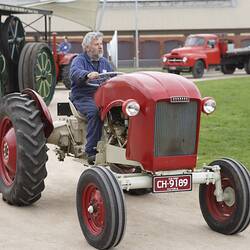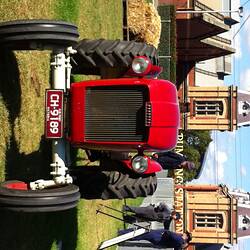Summary
Designed by Alan Hawker (Bob) Chamberlain in the late 1950s, the Chamberlain Light Tractor was intended to provide a smaller Australian-built tractor to compete with the popular Ferguson 'grey' TE20 model and its successor the MF-35 model tractor. Prior to 1956, Bob Chamberlain had been a director and chief designer with Chamberlain Industries Pty Ltd, based in the Perth suburb of Welshpool, Western Australia, that produced a range of large tractors suitable for broad-acre farming. Bob Chamberlain left the company in 1956 following a dispute with the Western Australian government which had taken a controlling interest in the firm. Bob Chamberlain and his family were prevented by a settlement agreement from producing any farm equipment which might compete with Chamberlain Industries products.
After returning to Melbourne, Bob Chamberlain continued to work on a design for a light tractor he had begun in late 1955. The Chamberlain family still owned the Rolloy Piston Company in Port Melbourne which supplied General Motors-Holden's with all their pistons for the Holden 132 cubic inch, six-cylinder 'grey motor'. By using the Holden engine as its power source, the new tractor could take advantage of the extensive GM-H sales and service network in rural areas. This concept had already been used successfully by Ferguson tractors which used a Standard Vanguard car engine. However Chamberlain also believed that a diesel engine option would give his tractor a marketing edge over the Ferguson. He modified a German MAN air-cooled four-cylinder diesel unit but had problems obtaining manufacturing approval from the parent company. The Holden-engined prototype tractor was built by the Rolloy Piston Company and finished in 1959 using a new six-speed transmission.
Trials at the University of Melbourne's Tractor Testing Station at Werribee in February 1960 showed that the Chamberlain Light Tractor delivered 39.6 belt horsepower at 2700 rpm. The Light Tractor was never put into production due to problems with obtaining tariff protection from imported (particularly British) tractors which still received a special lower tariff rate. There were problems as a result of this situation in convincing a local firm to build the Light Tractor as Chamberlain's company could not produce it under the terms of his agreement with the WA government. He approached Australian Motor Industries, Hawker de Havilland, International Harvester Australia and the Toowoomba Foundry without success.
Bob Chamberlain donated the prototype Light Tractor to the Museum in 1977.
Physical Description
Specifications: Engine: GMH 'Holden' 6-cylinder vertical-in-line, 4-stroke, petrol engine Bore x Stroke: 3 in (76.20 mm) x 3¼ in (82.55 mm) Capacity: 138 cu in (2.26 litres) Governed Speed: 2,700 r.p.m. Fuel: Super grade petrol Fuel Consumption: 0.75 lb/BHP hour Maximum Belt Power: 39.6 BHP (29.54 kW) @ 2700 rpm Maximum Torque: 77 lb ft (104 N m) Drawbar Pull: 4,300 lbf (19.1 kN) with 2410 lb (1099 kg) ballast Transmission: 3-forward & 1-reverse gear with high & low ratios Power Take-Off: Independent flat-belt pulley PTO capable of being coupled to either engine or ground speed. Implement Attachment: Ferguson standard 3-point linkage (no longer fitted) Wheelbase: 84 in (2134 mm) Overall Weight: 3430 lb (1,557 kg)
More Information
-
Collecting Areas
-
Acquisition Information
Donation from Mr Alan Hawker (Bob) Chamberlain, 09 Aug 1977
-
Maker
Rolloy Piston Co, Port Melbourne, Greater Melbourne, Victoria, Australia, circa 1959
-
Designer
Mr Alan Hawker (Bob) Chamberlain, Toorak, Greater Melbourne, Victoria, Australia, circa 1959
-
Brand Names
-
Classification
Agriculture & rural life, Internal combustion power, Tractors
-
Category
-
Discipline
-
Type of item
-
Overall Dimensions
3300 mm (Length), 1760 mm (Width), 1500 mm (Height), 1557 kg (Weight)
Overall Weight: 3430 lb (1,557 kg)
-
Keywords




















